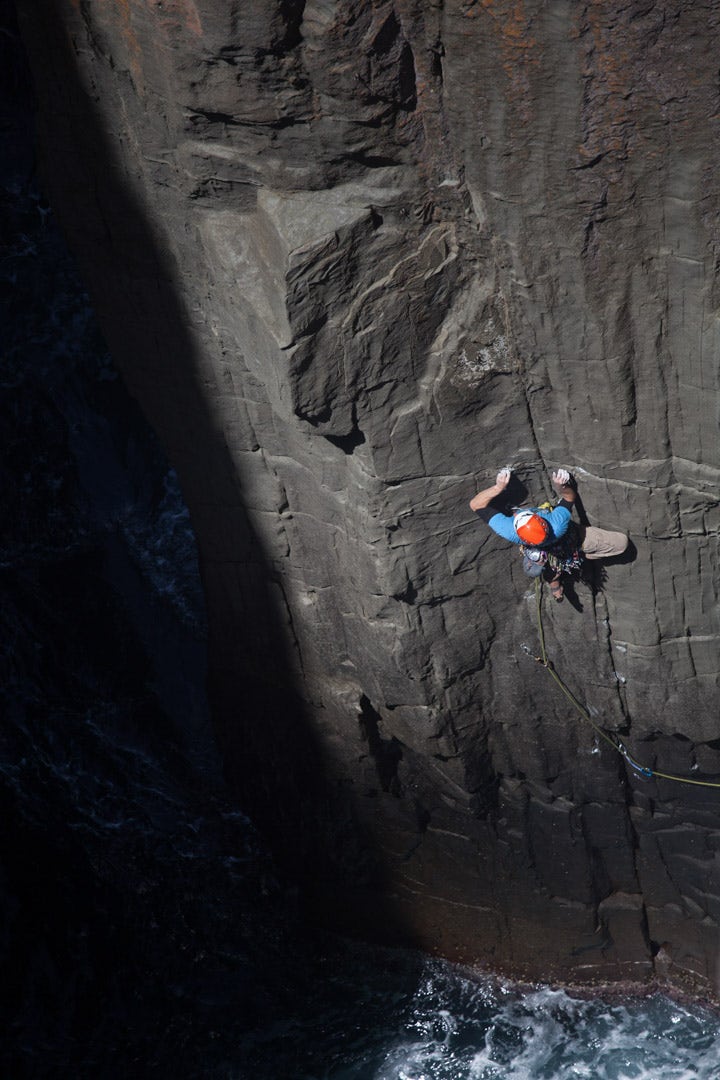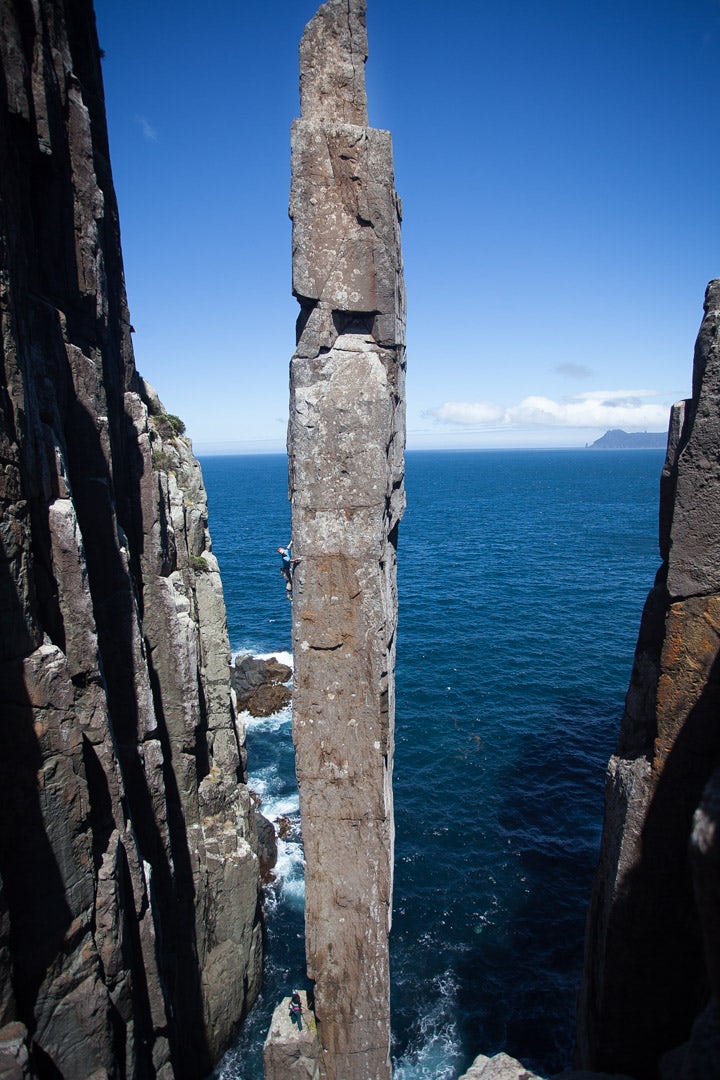

The Totem Pole defies superlatives as much as it defies the elements. If there were ever to be a feature that shouldn’t exist: it is this. Standing 60m tall and - most remarkable of all - a mere 4m wide, this great monolith stands defiant of the raging seas that surround it. However, stand it does; proud, tall, and implausible, representing a challenge to any adventurous rock climber that has a pulse.
Times change and things move on, and somehow, much like many other routes I’d previously thought impossible, the implausibility of doing it actually became…well…remarkably plausible
The Totem Pole first came on my radar 10 years ago, when I read the second of Paul Pritchard’s autobiographies. The story goes that upon winning the Boardman Tasker Prize for Mountain Literature, Paul bought a round the world ticket to visit, amongst many other places, Tasmania: home of the Totem Pole. Sadly what followed was an epic of gargantuan proportions, with a television sized block detaching itself from the Totem Pole and hitting him square on the head. Due to the Totem Pole’s location in the middle of a highly inaccessible channel, not to mention an hour and a half’s walk from civilisation, the rescue was extremely challenging and was largely executed by his climbing partner, Celia Bull. Celia saved his life, but the effect of the impact has left a lasting impression on Paul, with the rest of his book and the sequel that followed (The Longest Climb) recounting his road to recovery. As a result of this, its reputation for seriousness was born and it became a symbol for adventure: that lone, totemic monolith, striking out above an aggr
Back then I hadn’t even considered climbing it to be an option, it was light-years ahead of the standard I was climbing and the route’s reputation made it seem even further away. However, times change and things move on, and somehow - much like many other routes I’d previously thought impossible - the implausibility of doing it actually became…well…remarkably plausible. So, in December 2016 I boarded a long haul flight to Tasmania to repeat Paul Pritchard’s dream, albeit with the hope of doing it accident free.




When it comes to accessing the Totem Pole you first need to travel to the southern tip of Tasmania, to an area known as the Tasman Peninsula. The area gets pretty much all the weather going and is famed for its high winds and wild seas. From Fortescue Bay it is around an hour and a half walk to the lookout point just above the Totem Pole and its more substantial neighbour, the Candlestick. This is a worthy summit in its own right and is, conveniently, easier than the Totem Pole, albeit substantially less convenient to access (you need to swim to access it!). From here a scramble down leads you to a gearing up spot that really gives you an idea of what you’re about to let yourself in for. Just to repeat: it’s 60m tall and 4m wide. 4…metres…wide… it is at this point that any sane individual begins to ask themself - is this a good idea?






The first barrier to overcome is getting established on the pillar, which is easier said than done due to its location in the middle of a channel. From an abseil on the adjacent side of the zawn you need to gain enough momentum and bounce so that you can jump across and clip the double bolt belay at the base of the route. It is this point where you are at your most vulnerable to the sea, as the swell has been known to consume countless belayers beneath its waves. If there’s one thing I’m sure of, it’s that this doesn’t make climbing the Totem Pole any easier. Whilst the tides in Tasmania aren’t actually that sizeable, the swell is, so anyone wishing to head out and climb it will need to keep an eye on the state of the sea in order to secure safe access.
The start of the Deep Play is undeniably spooky, not least because of the close proximity to the sea and the fact you don’t want to end up in it. Thankfully protection is not far away, but the climbing becomes hard shortly after, with a few aggressive pulls that eventually lead you to easier ground and the perfect ledge - the calm before the storm
Pitch two consists of a long, striking arete. Part of the brilliance of this particular pitch, as mentioned previously, is that it combines perfect edges with an immaculate arête. What ensues would undoubtedly rate as one of the finest pitches of rock climbing I’ve ever done. Upon reaching the top you’re greeted with another ledge, then a short crack leading to the very summit. Standing on the very top of the Totem Pole is a surreal experience, as at this point you get a real indication of just how narrow the pillar you’ve climbed is, an intimidating final thought before the real fun begins: the tyrollean! Rather than say any more about this I’ll leave the following video to do all the talking!
In conclusion
So there you have it: a little bit about the Totem Pole, its history, and how to climb it. If you’re based in the UK it’s obviously an inconvenient distance away, but my goodness, its not a distance you’ll regret travelling. If you’ve read this and fancy planning a trip, anywhere between December and April would work. We went around Christmas time with the intention of the Totem Pole being our joint present, but in the end it became a New Year's Eve celebration. For more information on climbing in Tasmania, visit the UKC Destination Article here
If you've enjoyed reading Rob's Summit Special then you can find out more about his adventures on his website, Instagram or Twitter


Words by | Rob Greenwood


